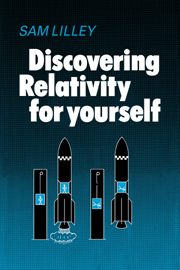Book contents
- Frontmatter
- Contents
- Preface
- Introduction
- 1 Getting started
- 2 Rough and ready Relativity
- 3 The dilation of time
- 4 Three clocks and a pair of twins
- 5 Starting again
- 6 Space–time diagrams
- 7 Time and distance ‘over there’
- 8 Co-ordinate systems
- 9 Combining speeds
- 10 Causality and the speed of light
- 11 The nature of spacetime
- 12 Interval
- 13 Old friends revisited
- 14 The scales of the spacetime diagram
- 15 The radar point of view
- 16 Relations between the radar and time–distance systems
- 17 Constant acceleration
- 18 Dynamics–mass, momentum, force
- 19 The mass–energy relation
- 20 The effect of acceleration on time measurement
- 21 Time as experienced by a constant acceleration traveller
- 22 Time and distance measurements of a constant acceleration observer
- 23 The Principle of Equivalence
- 24 The metric
- 25 Introducing geodesies
- 26 How to find ordinary geodesies
- 27 Inverse square law gravity
- 28 Curved spacetime
- 29 The metric around the Sun
- 30 Light and gravity
- 31 The scandal about Mercury
- 32 How Einstein did it
- 33 A few conclusions
- Index
18 - Dynamics–mass, momentum, force
Published online by Cambridge University Press: 15 March 2010
- Frontmatter
- Contents
- Preface
- Introduction
- 1 Getting started
- 2 Rough and ready Relativity
- 3 The dilation of time
- 4 Three clocks and a pair of twins
- 5 Starting again
- 6 Space–time diagrams
- 7 Time and distance ‘over there’
- 8 Co-ordinate systems
- 9 Combining speeds
- 10 Causality and the speed of light
- 11 The nature of spacetime
- 12 Interval
- 13 Old friends revisited
- 14 The scales of the spacetime diagram
- 15 The radar point of view
- 16 Relations between the radar and time–distance systems
- 17 Constant acceleration
- 18 Dynamics–mass, momentum, force
- 19 The mass–energy relation
- 20 The effect of acceleration on time measurement
- 21 Time as experienced by a constant acceleration traveller
- 22 Time and distance measurements of a constant acceleration observer
- 23 The Principle of Equivalence
- 24 The metric
- 25 Introducing geodesies
- 26 How to find ordinary geodesies
- 27 Inverse square law gravity
- 28 Curved spacetime
- 29 The metric around the Sun
- 30 Light and gravity
- 31 The scandal about Mercury
- 32 How Einstein did it
- 33 A few conclusions
- Index
Summary
So far we've not asked questions about what causes things to accelerate. When we do so, we enter the subject of dynamics. Naturally we shall be concerned with relativistic dynamics – the dynamics of things moving at high speed. But curiously enough the main difficulty for most of us will be to get a sound grasp of the fundamentals that belong just as much to Newtonian (slow-speed) dynamics. Making a thorough job of that would fill more pages than you would care to read (or pay for). So I'll make the best compromise I can between full explanation, a bit of fudging and a bit of ‘it can be proved that’. (If you're not interested in the dynamics, you can skip to Chapter 20, provided you can do without the mathematical practice that we'll get on the way.)
We all know that if something is stationary, you need a force to get it moving; and if it's moving, you need a force to stop it. We also know that some things are easier to get moving or to stop than others. A moderate push will get a car going. But try it on a bus! Things vary in the extent to which they resist being speeded up or slewed down. Mass is a quantity that gives a measure to this resistance – though we shall have to work out a more precise statement of this vaguely conceived idea.
(If you have been taught that mass measures the ‘quantity of matter’, please forget it. Also don't confuse mass with weight.
- Type
- Chapter
- Information
- Discovering Relativity for Yourself , pp. 194 - 201Publisher: Cambridge University PressPrint publication year: 1981



